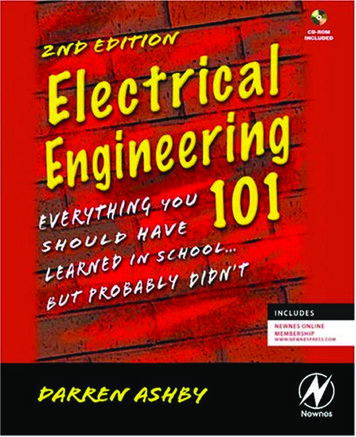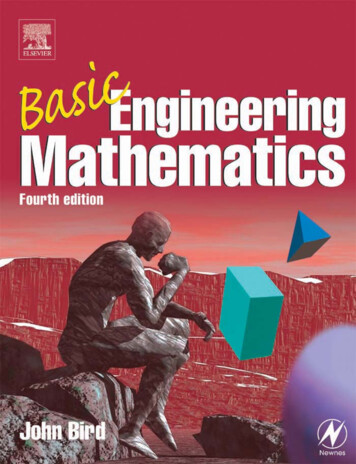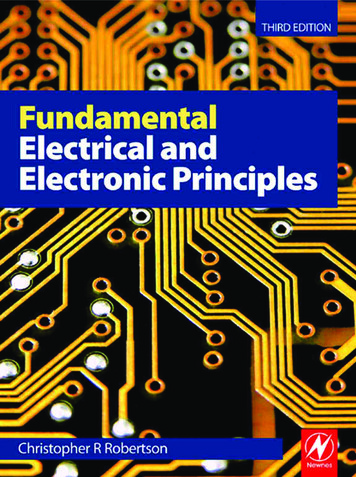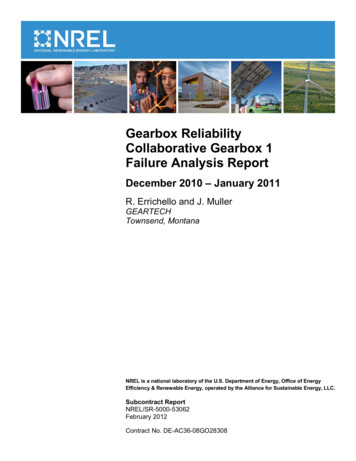
Transcription
Newnes is an imprint of Elsevier30 Corporate Drive, Suite 400Burlington, MA 01803, USALinacre House, Jordan HillOxford OX2 8DP, UKCopyright 2009, Elsevier Inc. All rights reserved.No part of this publication may be reproduced, stored in a retrieval system, ortransmitted in any form or by any means, electronic, mechanical, photocopying,recording, or otherwise, without the prior written permission of the publisher.Permissions may be sought directly from Elsevier’s Science & Technology RightsDepartment in Oxford, UK: phone: ( 44) 1865 843830, fax: ( 44) 1865 853333,e-mail: permissions@elsevier.com.uk. You may also complete your request onlinevia the Elsevier homepage (www.elsevier.com), by selecting “Customer Support”and then “Obtaining Permissions.”Recognizing the importance of preserving what has been written, Elsevier prints itsbooks on acid-free paper whenever possible.Library of Congress Cataloging-in-Publication DataAshby, Darren.Electrical engineering 101 : everything you should have learned in school . . .but probably didn’t / Darren Ashby.p. cm.Includes index.ISBN 978-1-85617-506-7 (alk. paper)1. Electric engineering. I. Title.TK146.A75 2009621.3—dc222008045182British Library Cataloguing-in-Publication DataA catalogue record for this book is available from the British Library.ISBN-13: 978-1-85617-506-7For information on all Newnes publicationsvisit our website at www.books.elsevier.com.08 09 10 11 1210 9 8 7 6 5 4 3 2 1Printed in Canada01 Y506 Prelims.indd iv10/21/2008 12:20:55 PM
PrefaceTHE FIRST WORDWow, the success of the original edition of Electrical Engineering 101 has beenamazing. I have had fans from all over the world comment on it and how thebook has helped them. The response has been all I ever hoped for—so muchso that I get a chance to add to it and make an even better version.Of course, these days you don’t just get a second edition, you get a better edition. This time through, you will get more insight into the topics (maybe a fewnew topics too), a hardcover with color diagrams, and hopefully a few morechuckles1 that mostly only we nerdy types will understand.If you want to know what this book is all about, here is my original preface:The intent of this book is to cover the basics that I believe have beeneither left out of your education or forgotten over time. Hopefully it willbecome one of those well-worn texts that you drop on the desk of thenew guy when he asks you a question. There is something for everystudent, engineer, manager, and teacher in electrical engineering. Mymantra is, “It ain’t all that hard!” Years ago I had a counselor in collegetell me proudly that they flunked out over half the students who startedthe engineering program. Needing to stay on her good side, I didn’tsay much at the time. I always wondered, though. If you fail so manystudents, isn’t that really a failure to teach the subject well? I say “It ain’tall that hard” to emphasize that even a hick with bad grammar like me canunderstand the world of electrical engineering. This means you can too!I take a different stance than that counselor of years ago, asserting thateveryone who wants to can understand this subject. I believe that waymore than 50% of the people who read this book will get something outof it. It would be nice to show the statistics to that counselor some day;she was encouraging me to drop out when she made her comment. Sogood luck, read on, and prove me right: It ain’t all that hard!1Just a hint, most of the chuckles are in the footnotes, and if you like those, check out theglossary too!vii
viiiPrefaceWell, that about says it all. If you do decide to give this book a chance, I wantto say thank you, and I hope it brings you success in all you do!OVERVIEWFor EngineersGranted, there are many good teachers out there and you might have gottenthe basics, but time and too many “status reports” have dulled the finish onyour basic knowledge set. If you are like me, you have found a few really goodbooks that you often pull off the shelf in a time of need. They usually have awell-written, easy-to-understand explanation of the particular topic you needto apply. I hope this will be one of those books for you.You might also be a fish out of water, an ME thrown into the world of electrical engineering, and you would really like a basic understanding to work withthe EEs around you. If you get a really good understanding of these principles,I guarantee you will surprise at least some of the “sparkies” (as I like to callthem) with your intuitive insights into problems at hand.For StudentsI don’t mean to knock the collegiate educational system, but it seems to methat too often we can pass a class in school with the “assimilate and regurgitate” method. You know what I mean: Go to class, soak up all the things theteacher wants you to know, take the test, say the right things at the right time,and leave the class without an ounce of applicable knowledge. I think manystudents are forced into this mode when teachers do not take the time to laythe groundwork for the subject they are covering. Students are so hard-pressedto simply keep up that they do not feel the light bulb go on over their heads orsay, “Aha, now I get it!” The reality is, if you leave the class with a fundamentalunderstanding of the topic and you know that topic by heart, you will be eminently more successful applying that basic knowledge than anything from theend of the syllabus for that class.For ManagersThe job of the engineering manager2 really should have more to it than isdepicted by the pointy-haired boss you see in Dilbert cartoons. One thing many2Suggested alternate title for this book from reader Travis Hayes: EE for Dummies and ThoseThey Manage. I liked it, but I figured the pointy-haired types wouldn’t get it.
Prefacemanagers do not know about engineers is that they welcome truly insightfultakes on whatever they might be working on. Please notice I said “truly insightful”; you can’t just spout off some acronym you heard in the lunchroom andexpect engineers to pay attention. However, if you understand these basics,I am sure there will be times when you will be able to point your engineers inthe right direction. You will be happy to keep the project moving forward, andthey will gain a new respect for their boss. (They might even put away theirpointy-haired doll!)For TeachersPlease don’t get me wrong, I don’t mean to say that all teachers are bad; in factmostof my teachers (barring one or two) were really good instructors. However,sometimes I think the system is flawed. Given pressures from the dean to coverX, Y, and Z topics, sometimes the more fundamental X and Y are sacrificed justto get to topic Z.I did get a chance to teach a semester at my own alma mater. Some of thesechapters are directly from that class. My hope for teachers is to give you anothertool that you can use to flip the switch on the “Aha” light bulbs over your students’ heads.For EveryoneAt the end of each topic discussed in this book are bullet points I like to callThumb Rules. They are what they seem: those “rule-of-thumb” concepts thatreally good engineers seem to just know. These concepts are what always ledthem to the right conclusions and solutions to problems. If you get bored witha section, make sure to hit the Thumb Rules anyway. There you will get the distilled core concepts that you really should know.ix
About the AuthorDarren Coy Ashby is a self-described “techno geek with pointy hair.” He considers himself a jack-of-all-trades, master of none. He figures his common sensecame from his dad and his book sense from his mother. Raised on a farm andgraduated from Utah State University seemingly ages ago, Darren has nearly20 years of experience in the real world as a technician, an engineer, and amanager. He has worked in diverse areas of compliance; production; testing;and, his personal favorite, R&D.He jumped at a chance some years back to teach a couple of semesters athis alma mater. For about two years, he wrote regularly for the online magazine Chipcenter.com. Darren is currently the director of electronics R&D at abillion-dollar consumer products company. His passions are boats, snowmobiles, motorcycles, and pretty much anything with a motor. When not at hisday job, he spends most of his time with his family and a promising R&D consulting/manufacturing firm he started a couple of years ago.Darren lives with his beautiful wife, four strapping boys, and cute little daughter next to the mountains in Richmond, Utah. You can email him with comments, complaints, and general ruminations at dashby@raddd.com.xi
CHAPTER 0What Is ElectricityReally?CHICKEN VS. EGGWhich came first, the chicken or the egg? I was faced with just such a quandarywhen I set down to create the original edition of this book. The way thatI found people got the most out of the topics was to get some basic ideas andconcepts down first; however, those ideas were built on a presumption of a certain amount of knowledge. On the other hand, I realized that the knowledgethat was to be presented would make more sense if you first understood theseconcepts—thus my chicken-vs.-egg dilemma.Suffice it to say that I jumped ahead to explaining the chicken (the chickenbeing all about using electricity to our benefit). I was essentially assuming thatthe reader knew what an egg was (the “egg” being a grasp on what electricityis). Truth be told, it was a bit of a cheat on my part,1 and on top of that I neverexpected the book to be such a runaway success. Turns out there are lots ofpeople out there who want to know more about the magic of this ever-growingelectronic world around us. So, for this new and improved edition of the book, Iwill digress and do my best to explain the “egg.” Skip ahead if you have an ideaof what it’s all about,2 or maybe stick around to see if this is an enlighteninglook at what electricity really is.1Do we all make compromises in the face of impossible deadlines? Are the deadlines onlyimpossible because of our own procrastination? Those are both very heavy-duty questions,not unlike that of the chicken-vs.-egg debate.2Thus the whole Chapter 0 idea; you can argue that 0 or 1 is the right number to start counting with, so pick whichever chapter you want to begin with of these two and have at it.1
2CHAPTER 0 What Is Electricity Really?SO WHAT IS ELECTRICITY?The electron—what is it? We haven’t ever seen one, but we have found ways tomeasure a bunch of them. Meters, oscilloscopes, and all sorts of detectors tellus how electrons move and what they do. We have also found ways to makethem turn motors, light up light bulbs, and power cell phones, computers, andthousands of other really cool things.What is electricity though? Actually, that is a very good question. If you digdeep enough you can find RSPs3 all over the world who debate this very topic.I have no desire to that join that debate (having not attained RSP status yet).So I will tell you the way I see it and think about it so that it makes sense in myhead. Since I am just a hick from a small town, I hope that my explanation willmake it easier for you to understand as well.THE ATOMWe need to begin by learning about a very small particle that is referred to asan atom. A simple representation of one is shown in Figure 0.1.Atoms4 are made up of three types of particles: protons, neutrons, and electrons. Only two of these particles have a feature that we call charge. The protoncarries a positive charge and the electron carries a negative charge, whereas theneutron carries no charge at all. The individual protons and neutrons are muchmore massive than the wee little electron. Although they aren’t the same size,the proton and the electron do carry equal amounts of opposite charge.Now, don’t let the simple circles of my diagram lead you to believe that thisis the path that electrons move in. They actually scoot around in a more energetic 3D motion that physicists refer to as a shell. There are many types andshapes of shells, but the specifics are beyond the scope of this text. You doneed to understand that when you dump enough energy into an atom, you canget an electron to pop off and move fancy free. When this happens the rest ofthe atom has a net positive charge5 and the electron a net negative charge.6Actually they have these charges when they are part of the atom. They simplyRSP Really Smart Person. As you will soon learn, I do hope to get an acronym or twointo everyday vernacular for the common engineer. BTW, I believe that many engineers areRSPs; it seems to be a common trait among people of that profession.4The atom is really, really small. We can sorta “see” an atom these days with some prettycool instruments, but it is kinda like the way a blind person “sees” Braille by feeling it.5An atom with a net charge is also known as an ion.6Often referred to as a free electron.3
The AtomProtonsNeutronsFIGURE 0.1Very basic symbol of an atom.FIGURE 0.2Electrons are “stuck” in these shells in an insulator; they can’t really leave and move fancy free.cancel each other out so that when you look at the atom as a whole the netcharge is zero.Now, atoms don’t like having electrons missing from their shells, so as soon asanother one comes along it will slip into the open slot in that atom’s shell. Theamount of energy or work it takes to pop one of these electrons loose dependson the type of atom we are dealing with. When the atom is a good insulator,such as rubber, these electrons are stuck hard in their shells. They aren’t movingfor anything. Take a look at the sketch in Figure 0.2.3
4CHAPTER 0 What Is Electricity Really?FIGURE 0.3An electron sea.In an insulator, these electron charges are “stuck” in place, orbiting the nucleusof the atom—kinda like water frozen in a pipe.7 Do take note that there are justas many positive charges as there are negative charges.With a good conductor like copper, the electrons in the outer shells of theatoms will pop off at the slightest touch; in metal elements these electronsbounce around from atom to atom so easily that we refer to them as an electronsea, or you might hear them referred to as free electrons. More visuals of thisidea are shown in Figure 0.3.You should note that there are still just as many positive charges as there arenegative charges. The difference now is not the number of charges; it is the factthat they can move easily. This time they are like water in the pipe that isn’t frozen but liquid—albeit a pipe that is already full of water, so to speak. Gettingthe electrons to move just requires a little push and away they go.8 One effectof all these loose electrons is the silvery-shiny appearance that metals have. Nowonder that the element that we call silver is one of the best conductors there is.One more thing: A very fundamental property of charge is that like chargesrepel and opposite charges attract.9 If you bring a free electron next to anotherfree electron, it will tend to push the other electron away from it. Gettingthe positively charged atoms to move is much more difficult; they are stuckin place in virtually all solid materials, but the same thing applies to positivecharges as well.107I like the frozen water analogy; just don’t take it too far and think you just need to meltthem to get them to move!8Analogies are a great way to understand something, but you have to take care not to takethem too far. In this case take note that you can’t simply tip your wire up and get the electrons to fall out, so it isn’t exactly like water in a pipe.9It strikes me that this is somewhat fundamental to human relationships. “Good” girls areoften attracted to “bad” boys, and many other analogies that come to mind.10There are definitely cases where you can move positive charges around. (In fact, it oftenhappens when you feel a shock.) It’s just that most of the types of materials, circuits, andso on that we deal with in electronics are about moving the tiny, super-small, commonlyeasy-to-move electron. For that other cool stuff, I suggest you find a good book on electromagnetic physics.
Now What?Thumb Rules Electricity is fundamentally charges, both positive and negative.Energy is work.There are just as many positive as negative charges in both aconductor and an insulator.In a good conductor, the electrons move easily, like liquid water.In a good insulator, the electrons are stuck in place, like frozenwater (but not exactly; they don’t “melt”).Like charges repel and opposite charges attract.NOW WHAT?So now we have an idea of what insulators and conductors are and how theyrelate to electrons and atoms. What is this information good for, and why dowe care? Let’s focus on these charges and see what happens when we get themto move around.First, let’s get these charges to move to a place and stay there. To do this we’lltake advantage of the cool effect that these charges have on each other, whichwe discussed earlier. Remember, opposite charges attract, whereas the samecharges repel. There is a cool, mysterious, magical field around these charges.We call it the electrostatic field. This is the very same field that creates everythingfrom static cling to lightning bolts. Have you ever rubbed a balloon on yourhead and stuck it on the wall? If so you have seen a demonstration of an electrostatic field. If you took that a little further and waved the balloon closelyover the hair on your arm, you might notice how the hairs would track themovement of the balloon. The action of rubbing the balloon caused your headto end up with a net total charge on it and the opposite charge on the balloon.The act of rubbing these materials together11 caused some electrons to movefrom one surface to the other, charging both your head and the balloon.This electrostatic field can exert a force on other things with charges. Thinkabout it for a moment: If we could figure out a way to put some charges on oneend of our conductor, that would push the like charges away and in so doingcause those charges to move.11Fun side note: Google this balloon-rubbing experiment and see what charge is where. Alsoresearch the fact that this happens more readily with certain materials than others.5
6CHAPTER 0 What Is Electricity Really?FIGURE 0.4Hypothetical electron pump.Figure 0.4 shows a hypothetical device that separates these charges. I will callit an electron pump and hook it up to our copper conductor we mentionedpreviously.In our electron pump, when you turn the crank, one side gets a surplus of electrons, or a negative charge, and on the other side the atoms are missing saidelectrons, resulting in a positive charge.12If you want to carry forward the water analogy, think of this as a pump hookedup to a pipe full of water and sealed at both ends. As you turn the pump, youbuild up pressure in the pipe—positive pressure on one side of the pump andnegative pressure on the other. In the same way, as you turn the crank youbuild up charges on either side of the pump, and then these charges push outinto the wire and sit there because they have no place to go. If you hook up ameter to either end you would measure a potential (think difference in charge)between the two wires. That potential is what we call voltage.NOTEIt’s important to realize that it is by the nature of the location of these charges that youmeasure a voltage. Note that I said location, not movement. Movement of these chargesis what we call current. (More on that later.) For now what you need to take away from thisdiscussion is that it is an accumulation of charges that we refer to as voltage. The morelike charges you get in one location, the stronger the electrostatic field you create.1312There is actually a device that does this. It is called a Van de Graaff generator, so it reallyisn’t hypothetical, but I really like the word hypothetical. Just saying it seems to raise my IQ!13There isn’t a good water analogy for this field. You simply need to know it is there; it is important to understand that this field exists. If you still don’t grasp this field, get a balloon and playwith it till you do. Remember, even the best analogies can break down. The point is to use theanalogy to help you begin to grasp the topic, then experiment till you understand all the details.
Now What?FIGURE 0.5Electron pump with light bulb.Okay, it’s later now. We find that another very cool thing happens when wemove these charges. Let’s go back to our pump and stick a light bulb on theends of our wires, as shown in Figure 0.5.Remember that opposite charges attract? When you hook up the bulb, onone side you have positive charges, on the other negative. These charges pushthrough the light bulb, and as they do they heat up the filament and make itlight up. If you stop turning the electron pump, this potential across the lightbulb disappears and the charges stop moving. Start turning the pump and theystart moving again. The movement of these charges is called current.14 The reallycool thing that happens is that we get another invisible field that is created whenthese charges move; it is called the electromagnetic field. If you have ever playedwith a magnet and some iron filings, you have seen the effects of this field.15So, to recap, if we have a bunch of charges hanging out, we call it voltage, andwhen we keep these charges in motion we call that current. Some typical wateranalogies look at voltage as pressure and current as flow. These are helpful to14Current is coulombs per sec, a measure of flow that has units of amperes, or amps.In a permanent magnet, all the electrons in the material are scooting around their respectiveatoms in the same direction; it is the movement of these charges that creates the magnetic field.157
8CHAPTER 0 What Is Electricity Really?Power Goes fromPump to LightFIGURE 0.6The electromagnetic and electronic fields transmit the work from the crank to the light bulb.grasp the concept, but keep in mind that a key thing with these charges andtheir movements is the seemingly magical fields they produce. Voltage generates an electrostatic field (it is this field repelling or attracting other chargesthat creates the voltage “pressure” in the conductor). Current or flow or movement of the charges generates a magnetic field around the conductor. It is veryimportant to grasp these concepts to enhance your understanding of what isgoing on. When you get down to it, it is these fields that actually move thework or energy from one end of a circuit to another.Let’s go back to our pump and light bulb for a minute, as shown in Figure 0.6.Turn the pump and the bulb lights up. Stop turning and it goes out. Start turning and it immediately lights up again. This happens even if the wires are long!We see the effect immediately. Think of the circuit as a pair of pulleys and abelt. The charges are moving around the circuit, transferring power from onelocation to another—see Figure 0.7.16Fundamentally, we can think of the concept as shown in the drawing in Figure 0.8.16This diagram is a simplified version of a scalar wave diagram. I won’t go into scalar diagrams in depth here, to limit the amount of information you need to absorb. However, I dorecommend that you learn about these when you feel ready.
Now What?LoadFIGURE 0.7The belt transmits the work from the crank to the load.Power Goes fromPump to LightLoadFIGURE 0.8The cool magical fields act like the belt transmitting what we call energy, work, or power.Even if the movement of the belt is slow,17 we see the effects on the pulleyimmediately, at the moment the crank is turned. It is the same way with thelight bulb. However, the belt is replaced by the circuit, and it is actually the17In fact the charges in the wire are moving much more slowly than one might think. Infact, DC current moves at about 8 CM per hour. (In a typical wire, exact speed depends onseveral factors, but it is much slower than you might think.) AC doesn’t even keep flowing,it just kinda bounces back and forth. If you think about it, you might wonder how flippinga switch can get a light to turn on so quickly. Thus the motor and belt analogy; it is the factthat the wire “pipe” is filled (in the same way the belt is connected to the pulley) with thesecharges that creates the instantaneous effect of a light turning on.9
10CHAPTER 0 What Is Electricity Really?electromagnetic18 fields pushing charges around that transmit the work to thebulb. Without the effects of both these fields, we couldn’t move the energyinput at the crank to be output at the light bulb. It just wouldn’t happen.Like the belt on the pulleys, the charges move around in a loop. But the workthat is being done at the crank moves out to the light bulb, where it is used upmaking the light shine. Charges weren’t used up; current wasn’t used up. Theyall make the loop (just like the belt in the pulley example). It is energy that isused up. Energy is work; you turning the crank is work. The light bulb takesenergy to shine. In the bulb energy is converted into heat on the filament thatmakes it glow so bright that you get light. But remember, it is energy that it takesto make this happen. You need both voltage and current (along with their associated fields) to transfer energy from one point to another in an electric circuit.Thumb Rules An accumulation of charges is what we call voltage.Movement of charges is what we call current or amperage.Energy is work; in a circuit the electromagnetic effects move energyfrom one point to another.A PREVIEW OF THINGS TO COMENow, all the electronic items that we are going to learn about are based onthese charges and their movement. We will learn about resistance—the measurement of how difficult it is to get these electrons to pop loose and move arounda circuit. We will learn about a diode, a device that can block these chargesfrom moving in one direction while letting them pass in another. We will learnabout a transistor and how (using principles similar to the diode) it can switcha current flow on and off.1918When I use the term electromagnetic, it is referring to the effects of both the electrostaticfield and the magnetic field that we have been talking about.19These are called semiconductors, and with good reason: They lie somewhere (semi-)between an insulator and a conductor in their ability to move charges. As you will learnlater, we capitalize on this fact and the cool effects that occur when you jam a couple of different types together.
It Just Seems MagicalWe will learn about generators and batteries and find out they are simply different versions of the electron pump that we just talked about.We will learn about motors, resistors, lights, and displays—all items that consume the power that comes from our electron pump.But just remember, it all comes back to this basic concept of a charge, the fieldsaround it when it sits there, and the fields that are created when the chargesmove.IT JUST SEEMS MAGICALOnce you grasp the idea of charges and how the presence and movement ofthese charges transfer energy, the magic of electricity is somewhat lost. If you getthe way these charges are similar to a belt turning a pulley, you are already further ahead in understanding than I was when I graduated from college. Whateveryou do, don’t let anyone tell you that you can’t learn20 this stuff. It really isn’t allthat magical, but it does require you to have an imagination. You might not beable to see it, but you surely can grasp the fundamentals of how it works.So give it a try; don’t say you can’t do this,21 because I am sure you can. If youread this book and don’t come away with a better grasp of all things electricaland electronic, please drop me a line and complain about it. As long as myinbox isn’t too clogged by email from all those raving reviews, I will be sure toget back to you.Thumb Rules 20“Can’t” is a sucker too lazy to try.Laziness is the mother of invention.Am I alone in my distaste for so-called weed-out courses? You know, the ones that theyput in the curriculum to get people to quit because they make them so hard. I personallybelieve that the goal of teachers should be to teach. It follows that the goal of a universityshould be to teach better, not just turn people away.21My dad always said, “Can’t is a sucker to lazy to try!” after learning this, I also went on todevelop a personal belief that laziness is the mother of invention. Does that mean the mostsuccessful inventors are those that are lazy enough to look for an easier way, but not so lazyas to try it?11
CHAPTER 1Three Things TheyShould Have Taughtin Engineering 101Do you remember your engineering introductory course? At most, I’ll venturethat you are not sure you even had a 101 course. It’s likely that you did and,like the course I had, it really didn’t amount to much. In fact, I don’t rememberanything except that it was supposed to be an “introduction to engineering.”Much later in my senior year and shortly after I graduated, I learned somevery useful general engineering methodologies. They are so beneficial thatI sincerely wish they had taught these three things from the beginning of mycoursework. In fact, it is my belief that this should be basic, basic knowledgethat any aspiring engineer should know. I promise that by using these in yourday-to-day challenges you will be more successful and, besides that, everyoneyou work with will think you are a genius. If you are a student reading this, youwill be amazed at how many problems you can solve with these skills. They arethe fundamental building blocks for what is to come.UNITS COUNT!This is a skill that one of my favorite teachers drilled into me during my senioryear. Till I understood unit math, I forced myself to memorize hundreds ofequations just to pass tests. After applying this skill I found that, with just afew equations and a little algebra, you could solve nearly any problem. Thiswas definitely an “Aha” moment for me. Suddenly the world made sense.Remember those dreaded story
books on acid-free paper whenever possible. Library of Congress Cataloging-in-Publication Data Ashby, Darren. Electrical engineering 101 : everything you should have learned in school . . . but probably didn’t / Darren Ashby. p. cm. Includes index. ISBN 978-1-85617-506-7 (alk. paper) 1.










